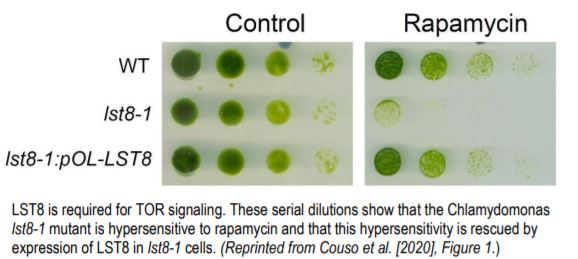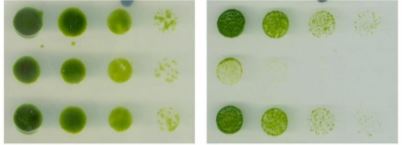Phosphorus Sensing by LST8 Acts as a TOR Guide for Cell Growth in Chlamydomonas
Plant cell growth is often limited by the availability of two key nutrients, phosphorus (P) and nitrogen (N). As in mammals and yeast, a kinase known as TOR (target of rapamycin) is a key nutrient-responsive regulator of primary metabolism and cell growth in plants (Gonzalez and Hall, 2017; Dobrenel et al., 2016; Wu et al., 2019). TOR responds to nutrient availability and stimulates protein synthesis while suppressing autophagy. Rapamycin (named for Rapa Nui = Easter Island), a macrolide antibiotic produced by Streptomyces hygroscopicus, blocks cell growth by inhibiting protein synthesis and inducing autophagy.
In yeast and animals, TOR is a component of a multiprotein complex known as TOR complex 1 (TORC1) that initiates a phosphorylation cascade that stimulates growth. The binding of LST8, a TORC1 component, to the kinase domain of TOR is required for full kinase activity. Plant TORC1 is activated by nutrient availability, light, and phytohormones, and it induces mRNAs and proteins involved in cell division and synthesis of starch and lipids. Both TOR and LST8 homologs are present in Chlamydomonas reinhardtii (reviewed in Pérez-Pérez et al., 2017), an excellent model system for nutritional studies. Couso et al. (2020) used a library of Chlamydomonas insertional mutants to isolate lst8-1, which has an insertion in the 3′ untranslated region of LST8. They show that lst8-1 is defective in TORC1 signaling and dissect the role of P starvation in the TOR signaling pathway.
CELL Image List – Current  Although the level of LST8 in lst8-1 cells was reduced by 60-70% relative to wild type (WT) cells, there was no growth defect in lst8-1. However, lst8-1 cells were hypersensitive to rapamycin, and this hypersensitivity disappeared when mutant cells were complemented with WT LST8 (see figure). Because this suggested altered TOR signaling, the authors tested growth kinetics and timing of autophagy in WT vs. lst8-1 cells in limiting N, but they saw no difference. In contrast, lst8-1 cells were hypersensitive to P starvation, and expression of LST8 restored the normal P-derived growth response. Also, unlike in limiting N, autophagy during P starvation in lst8-1 was much more rapid (8 h vs. 24-48 h).
Although the level of LST8 in lst8-1 cells was reduced by 60-70% relative to wild type (WT) cells, there was no growth defect in lst8-1. However, lst8-1 cells were hypersensitive to rapamycin, and this hypersensitivity disappeared when mutant cells were complemented with WT LST8 (see figure). Because this suggested altered TOR signaling, the authors tested growth kinetics and timing of autophagy in WT vs. lst8-1 cells in limiting N, but they saw no difference. In contrast, lst8-1 cells were hypersensitive to P starvation, and expression of LST8 restored the normal P-derived growth response. Also, unlike in limiting N, autophagy during P starvation in lst8-1 was much more rapid (8 h vs. 24-48 h).
The authors developed an assay to monitor TOR’s kinase activity and showed that, in P-replete conditions, lst8-1 cells showed reduced phosphorylation of a conserved Ser residue (Ser-245) in RPS6, a downstream target of TORC1 whose phosphorylation is blocked by rapamycin. Expression of LST8 rescued this defect, with no change in the level of TOR. They then investigated the role of LST8 in P-regulated TORC1 signaling by using the psr1 mutant, which is defective in PSR1, a Myb transcription factor that regulates P responses by upregulating genes such as phosphate transporters. As in lst8-1, the onset of autophagy in psr1 was earlier than in WT, and there was a surprising change in phosphorylation of Ser-245 in psr1.
The authors conclude with a model showing how, when P is plentiful, TOR stimulates translation and inhibits autophagy. P limitation sensed by LST8 activates PSR1, which is required to maintain P homeostasis. A deficiency in cellular P reduces the level of LST8 and downregulates TORC1, repressing protein synthesis, increasing autophagy, and suppressing cell growth.
Gregory Bertoni
Science Editor
ORCID ID: 0000-0001-7977-3724
REFERENCES
Couso, I., Pérez-Pérez, M.E., Ford, M.M., Martínez-Force, E., Hicks, L.M., Umen, J.G., and Crespo, J.L. (2020). Phosphorus availability regulates TORC1 signaling via LST8 in Chlamydomonas. Plant Cell. Published Jan. 2020. DOI: https://doi.org/10.1105/tpc.19.00179.
Dobrenel, T., Caldana, C., Hanson, J., Robaglia, C., Vincentz, M., Veit, B., and Meyer, C. (2016). TOR signaling and nutrient sensing. Annu. Rev. Plant Biol. 67, 261-285.
Gonzalez, A., and Hall, M.N. (2017). Nutrient sensing and TOR signaling in yeast and mammals. EMBO J 36, 397-408.
Pérez-Pérez, M.E., Couso, I., and Crespo, J.L. (2017). The TOR Signaling Network in the Model Unicellular Green Alga Chlamydomonas reinhardtii. Biomolecules 7 doi: 10.3390/biom7030054.
Wu, Y., Shi, L., Li, L., Fu, L., Liu, Y., Xiong, Y., and Sheen, J. (2019). Integration of nutrient, energy, light and hormone signalling via TOR in plants. J. Exp. Bot. 70:2227-2238




